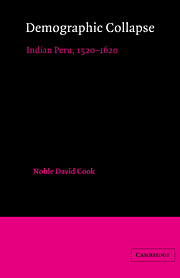Part I - Peru's preconquest population
Published online by Cambridge University Press: 02 December 2009
Summary
The debate over the size of human populations in pre-Columbian America and the changes in them during the centuries of European domination has long been characterized by wide differences of opinion and much fervor. In recent decades the debate continues, if anything with greater participation and, one suspects, with no diminution of emotion … Involved also in the debate are differences over method, evidence, and basic philosophy that have much to do with the positions taken.
Woodrow Borah, “Historical Demography: Attempt at Perspective,” P. 13The basic source for historical demography is the census. The Incas of Peru made periodic counts of their subjects and recorded the numbers on knotted-string mnemonic devices, which they called quipus. Pedro Cieza de Leon, writing in Cuzco in 1550, clearly explained why the native rulers wanted statistical information on the inhabitants and how the count was administered: “the principal men and their delegates in all towns and provinces of Peru had to keep track of the men and women who died and were born each year, for the purposes of tribute, and in order to know the number of warriors and defenders of the community.” At the appropriate time the Inca sent an official called a lunaquipo, or quipocamayo, to each province. The leaders of each valley met the imperial representative at a central place. The quipu records of the previous census were brought, note was made of deaths and births, and a new division of the population was made into several age categories.
- Type
- Chapter
- Information
- Demographic CollapseIndian Peru, 1520–1620, pp. 9 - 13Publisher: Cambridge University PressPrint publication year: 1982



